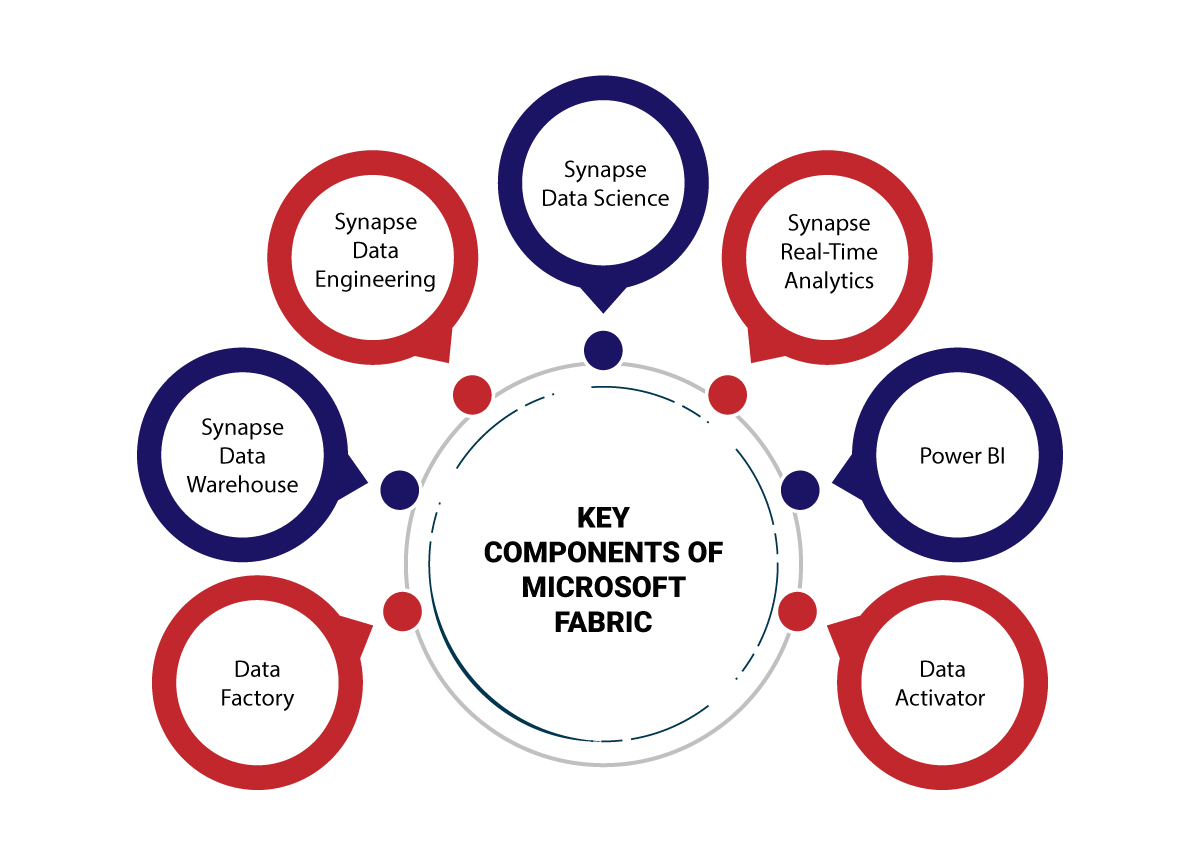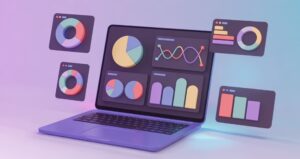Microsoft Fabric is an AI-powered unified data analytics platform from Microsoft. It combines components from Power BI, Azure Synapse, and Azure Data Factory, which are already part of the Azure universe, into one integrated environment.
Microsoft Fabric Data Analytics can be considered as the third generation of Microsoft data platforms. HDInsights and SQL Data Warehouse were introduced as the first generation, and Azure Synapse Analytics was introduced as the second generation. Now, we have Microsoft Fabric, a Software-as-a-Service (SaaS) analytics platform. This introductory blog aims to explore the features, benefits, and use cases of Microsoft Fabric across different industries.
What is Microsoft Fabric?
Microsoft Fabric is an all-in-one SaaS-based analytics solution that combines a comprehensive suite of services, including data lake, data engineering, data integration, data science, real-time analytics, and business intelligence, all in one place. It is built on top of three main tools and services in Microsoft – Azure Data Factory, Azure Synapse Analytics, and Power BI. It offers One Lake for one storage and One Security Microsoft Purview for Security and governance around it.
It is designed to simplify your analytics needs. Microsoft Fabric delivers a highly integrated, end-to-end, and easy-to-use product that makes it easy for business users and data engineers to manage and discover data.
Most organizations usually have separate teams dealing with Data Engineering, Data Warehouse and Data Lakes, Data Analytics, and Data Science. Typically, each team maintains its own independent data platforms and analytics solutions. This is where Microsoft Fabric helps unify everything into one platform to reduce duplication and minimize costs.
So essentially, Fabric brings everything into one umbrella to help manage an organization’s data infrastructure easily from one unified platform. Data engineers, developers, and administrators no longer have to work with multiple tools to bring everything together. It helps accelerate productivity for developers, improves time to value, and makes it easy for you to bring AI to your data. Let’s now explore the components of Microsoft Fabric.
Components of Microsoft Fabric
Microsoft Fabric architecture comprises seven components; each key component is tailored to a specific persona and a specific task. These run on top of One Lake and One Security and are designed to work together seamlessly.

Data Factory
It combines the power and scale of Azure Data Factory with the low code experience in Power Query. to help you set up data pipelines or data flow as part of data engineering. It provides more than 150 connectors to integrate data from a variety of cloud and on-premise sources, such as on-premises data warehouses, cloud data lakes, and SaaS applications data, to help you orchestrate data pipelines and automate data transformation.
Synapse Data Warehouse
The brand-new Synapse Data Warehouse now separates computing and storage and provides infinite scale. It has industry-leading SQL performance on open data formats for a converged lake house and data warehouse experience. It works with all data natively in an open storage format based on Parquet and Delta Lake and is a fully managed, cloud-scale analytics service that can be used to store and analyze large amounts of data.
Synapse Data Engineering
The new spark experience enables developers with great authoring experiences to build and manage data pipelines instantly. It allows instant start with live pools and the ability to collaborate, which helps enhance their productivity. MS Fabric delivers a delightful, unified experience in Synapse Data Engineering for data engineering tasks, such as data ingestion, transformation, and orchestration.
Synapse Data Science
Microsoft Fabric delivers a brand-new Synapse Data Science experience backed by the power of Azure machine learning. It provides a collaborative environment for data scientists to build and deploy machine learning models, work together, and offer various tools and resources for machine learning development.
Synapse Real-Time Analytics
Synapse Real-Time Analytics, based on Synapse Data Explorer or Azure Data Explorer, is a fully managed big data analytics platform optimized for streaming and time-series data. This data is often semi-structured in formats like XML and JSON from IoT devices or your application telemetry or log data. It stands out for its ability to ingest data from various sources.
Power BI
It acts as a bridge to help business users take data insights to the next level. Recognized for its strong visualization and data-driven analytics capabilities, Power BI is an excellent tool for extracting insights for data-driven decisions.
Data Activator
Data Activator is a no-code product that provides real-time detection and monitoring of data and triggers notifications and actions when business conditions are met. It helps you create a system of detection that continuously monitors your analytics and automatically alerts your team with relevant information so you can respond to insights and data in real-time.
Microsoft Fabric Features
Microsoft Fabric provides a wide range of features and capabilities as a comprehensive data analytics platform. Let’s explore key Microsoft fabric features.
Complete Analytics Platform
Microsoft Fabric integrates multiple subsystems to deliver a unified experience to extract insights from data. It thus aligns your team with a single source of truth by unifying data from different sources and platforms within a single, centralized repository built for performance, simplicity, and consistency.
It offers a comprehensive set of capabilities that cover the end-to-end data analytics lifecycle. This eliminates the need for time-consuming, complex integration efforts.
Microsoft One Lake: Lake-Centric and Open Architecture
Fabric offers One Lake – a single unified SaaS data lake for the entire organization to store everything from your data lake, files, databases, and more in a unified format. It parallels what OneDrive is for Office 365, where you can store everything.
The open and lake-centric hub helps unify your data estate and enables data engineers to connect and curate data from multiple sources. It serves as a unified storage system, thus eliminating siloed data systems and enabling easy data discovery that is shared by all analytics engines. MS Fabric also deeply embraces open data formats and open APIs. Since different proprietary analytics engines use different proprietary formats, Microsoft Fabric greatly simplifies data infrastructure for enterprises without locking them into a single cloud vendor.
Empowers Every Business User
Microsoft Fabric offers role-specific experiences and a suite of personalized analytics tools tailored to personas from data engineers, data scientists, C-level executives, Data architects, and business analysts. The right tools and capabilities help them independently generate real-time insights, which makes collaboration easier and helps everyone on the team be more productive.
AI-Powered
Fabric integrates the power of Azure OpenAI Service and large language models across Fabric experiences to help you interpret data quickly. It also offers an array of AI features, including copilot capabilities and ChatGPT-like experiences, which help unlock new insights to create data flows and get amazing insights from all of your data.
Comprehensive Capabilities
The Microsoft Fabric data analytics platform offers comprehensive features and experiences designed to work seamlessly. These capabilities are tailored for specific personas, including data movement, data lakes, data engineering, data integration, data science, real-time analytics, and business intelligence.
Microsoft Fabric Benefits
Microsoft Fabric turns your enterprise’s large and complex data repositories into actionable workloads and analytics and implements data mesh architecture. Microsoft Fabric streamlines the analytics process by eliminating the need to navigate through multiple tools and services. Let’s explore the advantages of Microsoft Fabric.
Simplifies Data Pipeline Management
Microsoft Fabric data analytics helps break down data silos by providing robust tools and capabilities for data pipeline management. You can efficiently use the extensive range of deeply integrated analytics to integrate all data and services seamlessly. It allows your IT team to configure core enterprise capabilities and permissions that are instantly and automatically applied to all the platforms. Fabric integrates and manages the underlying infrastructure, thus allowing your team to concentrate on high-quality work.
Streamlines Data Processing
Microsoft fabric SaaS experience makes it possible to analyze and process large quantities of data in real-time. Fabric thus helps in making data-driven decisions to improve business agility. Fabric reduces the time it usually takes to process raw data for business intelligence. By consolidating all aspects of the data journey, from consolidation, data provisioning, transformation, and modeling to analysis, Fabric empowers every business user.
Unified Platform Reduces Cost
Today, enterprises combine multiple analytics products from different vendors in a single project. However, when one system is not in use, the capacity remains idle and cannot be used by another system. Thus causing significant wastage. As a single unified tool, Microsoft Fabric offers an inclusive approach and allows you to utilize all workloads in a unified experience. This helps reduce cost and allows you to use unused computing capacity in an idle system. You only need to invest in a single SaaS Fabric platform for multiple analytics tasks, which translates into significant savings.
Data Governance Compliance and Data Security
Often, when organizations have separate teams, data governance, security, and privacy may be overlooked. Microsoft Fabric helps you overcome this challenge with the One Security/ Microsoft Purview. It enables you to set global policies for your data governance and Security from one place. Since it is a unified platform, Microsoft Fabric features robust security features, making implementing data security features instantly across all analytics tools easier.
Enhanced Productivity
The unified platform fosters seamless data sharing and collaboration, eliminating the need to shuffle between disparate tools. Moreover, Fabric enables and empowers every team with the buyer-specific experience they need, which further helps them access, manage, and act on data and insights faster.
Now that you’ve explored the standout features and benefits of Microsoft’s unified data analytics solution, let’s take you through some of the top use cases of Microsoft Fabric that can help bring your enterprise data into the era of AI.
Microsoft Fabric Use Cases Across Industries
Microsoft Fabric is a unified AI-powered analytics platform that helps turn data into a competitive advantage across different industries. Let’s see the practical uses of Microsoft Fabric below:
Manufacturing
- In the smart factory of Industry 4.0, data is constantly generated from numerous sources like production lines, IoT, and machinery. Microsoft Fabric helps gain real-time visibility into their operations by integrating real-time data from production lines, supply chains, and quality control systems into MS Fabric’s data lake. The unified view can identify bottlenecks, predict maintenance needs, and optimize production schedules.
- Microsoft Fabric can be used to track the condition of assets and predict when assets are likely to fail. This can help to schedule preventive maintenance and avoid costly unplanned downtime.
- By leveraging insights from Microsoft Fabric, manufacturing companies can reduce costs, improve product quality, and enhance customer satisfaction through timely deliveries and streamlined processes.
Healthcare
- Healthcare providers can leverage Fabric’s unified platform and One Lake to consolidate, manage, and analyze patient data from a variety of sources, including EHRs, medical imaging data, wearable devices, and research data sets, to improve medical research and patient care.
- Healthcare providers can use Microsoft Fabric to build a secure and scalable patient record system.
- Seamless integration enables researchers and medical practitioners to collaborate, gain insights from data, and make decisions to deliver better patient care. The persona-based experience feature in Fabric further helps foster multidisciplinary research by enabling collaborative research when working on large and complex medical datasets.
E-commerce
- E-commerce companies can use Microsoft Fabric to leverage data factory to consolidate data from various cloud and on-premise sources and enable a deep analysis of consumer behavior to help curate targeted marketing strategies.
- Microsoft Fabric can track and analyze marketing campaigns like clicks, impressions, and conversions. This can help retailers to improve the effectiveness of their marketing campaigns.
- Power BI within Microsoft Fabric can help visualize the data into persona-specific insights to understand customer trends and marketing strategies better.
Financial Services
- As a unified data analytics platform, MS Fabric helps financial services organizations integrate data from various sources for a holistic view. It has the potential to revolutionize how organizations work with data in the future.
- Microsoft Fabric can be used to analyze data about customer risk to develop more accurate pricing models. This can help financial institutions to charge customers fair prices for their products and services.
- Risk-based pricing: Microsoft Fabric can analyze customer risk data to develop more accurate pricing models. This can help financial institutions to charge customers fair prices for their products and services.
How Rishabh Can Help You Leverage Microsoft Fabric Data Analytics
As one of the leading Data Analytics Services providers, Rishabh Software can help you leverage the benefits of Microsoft Fabric. Our team of skilled data scientists, data engineers, and data analytics developers can guide you through seamless integration with Fabric’s powerful features to restructure your data analytics processes.
Our certified Microsoft experts can help you seamlessly integrate the MS Fabric platform into your business operations to help discover new opportunities and hidden threats and identify core audiences. Our Microsoft Gold Data Analytics competency for over two decades can benefit your business with easy access to the Microsoft ecosystem. This would include tools, programs, and on-demand tech support for end-to-end analytics solutions that are scalable, reliable, and cost-effective.
Conclusion
Microsoft Fabric is expected to fuel the next generation of AI applications. It is predicted that what the supercomputer did for the infrastructure layer, Microsoft Fabric, will do to the data layer for the next generation of AI applications. Combining several leading technologies under one umbrella, Microsoft Fabric’s lake-centric and open approach to data can help overcome the challenge of data silos and vendor lock-in. At Rishabh Software, we can be your trusted data analytics partner to use Fabric’s path-breaking capabilities and help your organization lead in the era of AI.
Frequently Asked Questions
Q: How does Microsoft Fabric support open data formats?
A: Microsoft Fabric uses the Open Delta Lake format on top of Parquet files as its native data format for all workloads. Microsoft Fabric also supports a wide range of other open data formats, including Parquet, JSON, and CSV. This ensures that users only need to load data into one Lake once and gives them the flexibility to move data between different formats using several tools and services. Thus, Fabric allows users to choose the best open data format for their needs and promotes interoperability between different data systems.
Q: How does Microsoft Fabric differ from other analytics platforms?
A: What sets Microsoft Fabric apart from other analytics platforms is its unique capability to deliver a comprehensive, seamless analytics solution all within one platform. This simplifies the challenges and expenses linked to integrating various systems and solutions from various providers. Features like One Security and One Lake defined features of Microsoft Fabric. It brings everything into one umbrella and equips you with tailored tools and persona-specific experiences so that you can use one platform rather than multiple different tools when managing entire organizations.
Q: How much does Microsoft Fabric pricing cost?
A: Microsoft Fabric Pricing is all about capacity. Here are details about the licensing and cost of Fabric capacities and how existing Power BI licenses allow you to access MS Fabric.
Firstly, Microsoft Fabric is available under two pricing models:
- Pay-As-You-Go Hourly or Monthly Model: You can go to the Azure portal to create a Fabric capacity under Pay-as-you-go Monthly or hourly. You can choose from the capacity units F2 SKU all the way up to F2048 SKU. Capacity units (CU) are used to measure the compute power available for each SKU.
- Reserved Instance: A reserved instance option will be introduced soon, and it will be the equivalent of what you can pay for a Power BI Premium capacity today.
There will also be an extra cost for storage because data storage could get quite large if you take full advantage of One Lake.
One Lake Storage/Month: One Lake will come with a certain amount of storage. You will be charged for extra storage if you exceed the set limit
Existing Power BI Licensing to Access MS Fabric
- Power BI Premium: Power BI Premium capacities provide all of the Fabric capabilities.
- Fabric Free Trial: The Power BI Free License has been renamed to Power Fabric Free, allowing you to enter the portal and access My Workspace. Microsoft also offers a Full Fabric Capacity Free 60-day Trial at the F64 units SKU.
- Power BI Pro License: The Power BI Pro License is available at $10/month and allows you to create Power BI reports within MS Fabric. So even if you have a Fabric capacity, you are still required to have a Power BI Pro license content within MS Fabric.











 30 Min
30 Min


